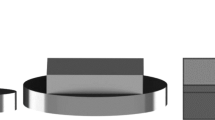Abstract
The work is devoted to the study of direct soldering of a substrate of Al2O3 ceramics with a Cu substrate by use of Bi11Ag2La solder. Soldering was realised by fluxless method in air by activation with power ultrasound. It was found out that lanthanum is during the ultrasonic soldering process distributed to the interface with Al2O3 substrate, enhancing thus the bond formation. The bond with ceramic substrate has adhesive character without formation of a new contact interlayer. The shear strength of joint with Al2O3 ceramics is 20 MPa.




















Similar content being viewed by others
References
Suganuma K, Kim SJ, Kim KS (2009) High-temperature lead-free solders: properties and possibilities. JOM 61(1):64–71
Chidambaram V, Hattel J, Hald J (2010) Design of lead-free candidate alloys for high-temperature soldering based on the Au–Sn system. Mater Des 31(10):4638–4645. https://doi.org/10.1016/j.matdes.2010.05.035
Kroupa, A., Andersson, D., Hoo, N. et al. Current problems and possible solutions in high-temperature lead-free soldering. In J Mater Eng Perform, Vol. 21, is. 5, 2012, pp. 629–637
Watson J, Castro G (2012) High-temperature electronics pose design and reliability challenges. Analog Dialogue 46-04:1–7
Chidambaram V, Hattel J, Hald J (2011) High-temperature lead-free solder alternatives. Microelectron Eng 88(6):981–989. https://doi.org/10.1016/j.mee.2010.12.072
Manikam VR, Cheong KY (2011) Die attach materials for high temperature applications: a review. IEEE Trans Compon Packag Manuf Technol 1(4):457–478
Gayle FW, Becka G, Badgett J et al. (2001) High temperature lead-free solder for microelectronics. JOM 17–21
Koleňák R, Hlavatý I (2009, arcitle No. 1727) Lead-free solders intended for higher temperatures. Trans VŠB – Tech Univ Ostrava, Mech Ser LV(3):113–117
Schoeller H, Bansal S, Knobloch A et al (2011) Effect of alloying elements on the creep behaviour of high Pb-based solders. Mater Sci Eng 528(3):1063–1070. https://doi.org/10.1016/j.msea.2010.10.083
Shi Y, Fang W, Xia Z et al (2010) Investigation of rare earth-doped BiAg high-temperature solders. J Mater Sci Mater Electron 21(9):875–881. https://doi.org/10.1007/s10854-009-0010-5
Song JM, Chuang HY, Wu ZM (2006) Interfacial reactions between Bi-Ag high-temperature solders and metallic substrates. J Electron Mater 35(5):1041–1049. https://doi.org/10.1007/BF02692565
Song JM, Chuang HY, Wu ZM (2007) Substrate dissolution and shear properties of the joints between Bi-Ag alloys and Cu substrate for high-temperature soldering applications. J Electron Mater 36(11):1516–1523. https://doi.org/10.1007/s11664-007-0222-5
Rettenmayr M, Lambracht P, Kempf B, Graff M (2005) High melting Pb-free solder alloys for die-attach applications. Adv Eng Mater 7(10):965–969. https://doi.org/10.1002/adem.200500124
Chachula M, Koleňák R, Augustín R, Koleňáková M (2011) Wettability of Bi11Ag solder during flux application. Metal, Brno
Yamada Y, Takaku Y, Yagi Y et al (2006) Pb-free high temperature solders for power device packaging. Microelectron Reliab 46(9-11):1932–1937. https://doi.org/10.1016/j.microrel.2006.07.083
Yamada Y, Takaku Y, Yagi Y et al (2006) Novel Bi-based high-temperature solder for mounting power semiconductor devices. R&D Rev Toyota CRDL, Research Report 41(2):43–48
Song JM, Chuang HY (2009) Faceting behaviour of primary ag in Bi-Ag alloys for high temperature soldering applications. Mater Trans 50(7):1902–1904. https://doi.org/10.2320/matertrans.M2009089
Song JM, Chuang HY, Wen TX (2007) Thermal and tensile properties of Bi-Ag alloys. Metall Mater Trans 38(6):1371–1375. https://doi.org/10.1007/s11661-007-9138-1
Lalena JN, Dean NF, Weiser MW (2002) Experimental investigation of Ge-doped Bi-11Ag as a new Pb-free solder alloy for power die attachment. J Electron Mater 31(11):1244–1249. https://doi.org/10.1007/s11664-002-0016-8
Spinelli JE, Silva BL, Garcia A (2014) Microstructure, phases morphologies and hardness of a Bi-Ag eutectic alloy for high temperature soldering applications. Mater Des 58:482–490. https://doi.org/10.1016/j.matdes.2014.02.026
Fima P, Gasior W, Sypien A, Moser Z (2010) Wetting of Cu by Bi-Ag based alloys with Sn and Zn additions. J Mater Sci 45(16):4339–4344. https://doi.org/10.1007/s10853-010-4291-0
Koleňák R, Martinkovič M, Koleňáková M (2013) Shear strength and DSC analysis of high-temperature solders. Arch Metall Mater 58(2):529–533
Song JM, Tsai CH, Fu YP (2010) Electrochemical corrosion behaviour of Bi-11Ag alloy for electronic packaging applications. Corros Sci 52(7):2519–2524. https://doi.org/10.1016/j.corsci.2010.03.031
Koleňák R, Chachula M (2013, ISSN 0954–0911) Characteristics and properties of Bi-11Ag solder. Soldering Surf Mount Technol 25(2):68–75
Lanin VL (2010) Activation of melts by the energy of ultrasonic and infrared fields. Surf Eng Appl Electrochem 46(5):469–476. https://doi.org/10.3103/S106837551005011X
Elliott RP, Shunk FA (1980) The Ag−Bi (Silver-Bismuth) system. Bull Alloy Phase Diagr 1(2):62–64
Chakrabarti DJ, Laughlin DE (1984) The Bi−Cu (bismuth-copper) system. Bull Alloy Phase Diagr 5(2):148–155. https://doi.org/10.1007/BF02868951
Acknowledgments
The authors thank Ing. Marián Drienovský, PhD. for DSC analysis, Ing. Martin Sahul, PhD. for EDX analysis, RNDr. Petr Harcuba for microscopic analysis and then to Prof. Ing. Maroš Martinkovič, PhD. for providing the methodics for shear test measurement.
Funding
The contribution was prepared with the support of APVV–0023–12 project: Research of new soldering alloys for fluxless soldering with application of beam technologies and ultrasound and VEGA 1/0089/17 project: Research of new alloys for direct soldering of metallic and ceramic materials.
Author information
Authors and Affiliations
Corresponding author
Additional information
Recommended for publication by Commission XVII - Brazing, Soldering and Diffusion Bonding
Rights and permissions
About this article
Cite this article
Koleňák, R., Hodúlová, E. Study of direct soldering of Al2O3 ceramics and Cu substrate by use of Bi11Ag2La solder. Weld World 62, 415–426 (2018). https://doi.org/10.1007/s40194-017-0538-6
Received:
Accepted:
Published:
Issue Date:
DOI: https://doi.org/10.1007/s40194-017-0538-6




